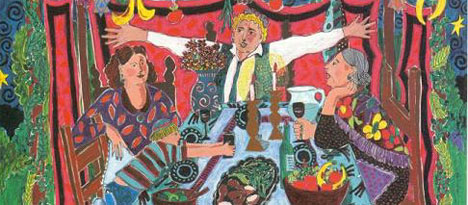The Beauty of Numbers – 5
“Israel’s ministry was to purchase every single day with blameless blood. Every morning and evening enjoyed by the nations was paid for in Yahweh’s name.”
Part 1 | Part 2 | Part 3 | Part 4
After the spectacular stories of Balaam and Phinehas, it is no wonder the modern mind has problems when the Torah suddenly crunches its gears to speak once again in detail about offerings. To the higher critic, this is simply evidence of a hodgepodge of scrolls gathered together by an ignorant and hurried scribe. For the believer, it adds to the niggling sense that the Bible has an internal logic which neither your pastor nor any Christian book you have read so far seems to be able to solve, despite many valiant attempts.
In his The Literary Structure of the Old Testament, David Dorsey sees some interesting chiastic structures in the Torah. For instance, he begins one structure at the defeat of Sihon and Og in Numbers 21 and ends it at Moses’ speech concerning the victory over Sihon and Og in Deuteronomy 2. To me, these seem to be historical structures more than literary ones, events rather than the careful arrangement of the text. Also, this sort of wooden symmetry can sometimes be imposed by skipping the bits of text that don’t fit. It doesn’t seem to hear the Bible’s textual “music.” We’ve all seen chiastic charts that aren’t quite symmetrical. Perhaps the Bible Matrix would knock the kinks out of them.
Certainly, we need to be aware of both historical and textual symmetry, but the arrangement of the text itself is a crucial part of the communication of the author. At least in his Numbers examples, Dorsey seems to overlook this aspect. Unlike most chiasmus fanboys, I don’t believe that mere identification of symmetry is what we really need to be spending our time on. The Bible’s “progressive” chiasmus is more architectural, more musical, more beautiful, more rich… and much more fun.
We come to the fifth cycle of the Wilderness Book, Numbers 28-29, which consists of a rundown of Israel’s annual festal offerings. The first thing we need to ask is this: If we have passed the centre of the book, and are now on our way out, what did we see on the way in that might explain this strange and sudden deviation into lawgiving?
Overview of Numbers
1 – Israel called and arranged as a New Creation
2 – Leadership disputes, failures and judgments
3 – Levitical offerings and “firstfruits” victories
4 – Israel fails the jealous inspection
5 – Israel’s national festal offerings
6 – Yet to see
7 – Yet to see
So, there we have the structural logic revealed. This festal passage is the “Deuteronomy” of the book of Numbers, if you will. Firstfruits concerns the Covenant Head. The offerings are Levitical ones, the ones “lifted up” above the Land. Maturity concerns the Covenant Body. The offerings are those of all the other tribes, the ones farming, subduing the Land. As such, this cycle is different to the one in Leviticus 23, which concerns the priestly offerings. These offerings are kingly. If you remember, the first cycle was a microcosm of the entire book. Whereas Israel offered basins in the initial cycle (as symbolic bulls) to prove their fealty, now they are offering actual animals. The Tabernacle of stone, wood and metal has taken on flesh.
The first key to Maturity is plunder versus plagues, depending upon obedience to the promises. The second key is the assembly, or rather, re-assembly of Israel after her being dismantled in the sacrificial process.
The question is why the Lord chose the festal calendar to express all of this. It must be because Israel’s harvest year pictured the fruit of the Spirit. The cycle begins with the Lord’s reference to these offerings as a pleasing aroma. Ascension, Testing and Maturity are the triune process of Altar, Fire and Smoke.
So in cycle three, the Head of the sacrifice was offered. Here in cycle five, the Body is offered.
As a new festal “week,” these verses work through Days 1 to 7, communicated in the symbolic qualities of the Lord speaking (Day 1), unblemished lambs offered “day by day,” in the morning and in the evening (Day 2 – Veil/Firmament), flour (Day 3 – Land/Grain) mixed with beaten oil (Day 4 – Pentecost), a pleasing aroma (Day 5 – swarms/clouds), a drink offering (Day 6 – blood, Mediators). Finally, the offering for the Sabbath is specified as twice the offering of every other day, and with double the flour. Israel’s ministry was to purchase every single day with blameless blood. Every morning and evening enjoyed by the nations was paid for in Yahweh’s name.
We’ve seen the Sabbath “week,” the Passover “month,” and we come to the “year-old” of the firstfruits lamb. The festal year is a gradual expansion of the Sabbath week. The actual firstfruits lamb is not mentioned here. That lamb is the head. These offerings must be the body.
Just as the Light of Day 1 became the Governing Lights of Day 4, so we have the Sabbath week opened into the Feast of Weeks. Here it is grouped with the firstfruits, head and body as one.
________________________________________
[1] See also The Three Shepherds – 1.
[2] It is a “bullock countown”!
First day: 13 Bullocks 2 Rams 14 Lambs 1 Goat
Second day: 12 Bullocks 2 Rams 14 Lambs 1 Goat
Third day: 11 Bullocks 2 Rams 14 Lambs 1 Goat
Fourth day: 10 Bullocks 2 Rams 14 Lambs 1 Goat
Fifth day: 9 Bullocks 2 Rams 14 Lambs 1 Goat
Sixth day: 8 Bullocks 2 Rams 14 Lambs 1 Goat
Seventh day: 7 Bullocks 2 Rams 14 Lambs 1 Goat
In all there are 70 bullocks, 14 rams, 98 lambs, and 7 goats.


























